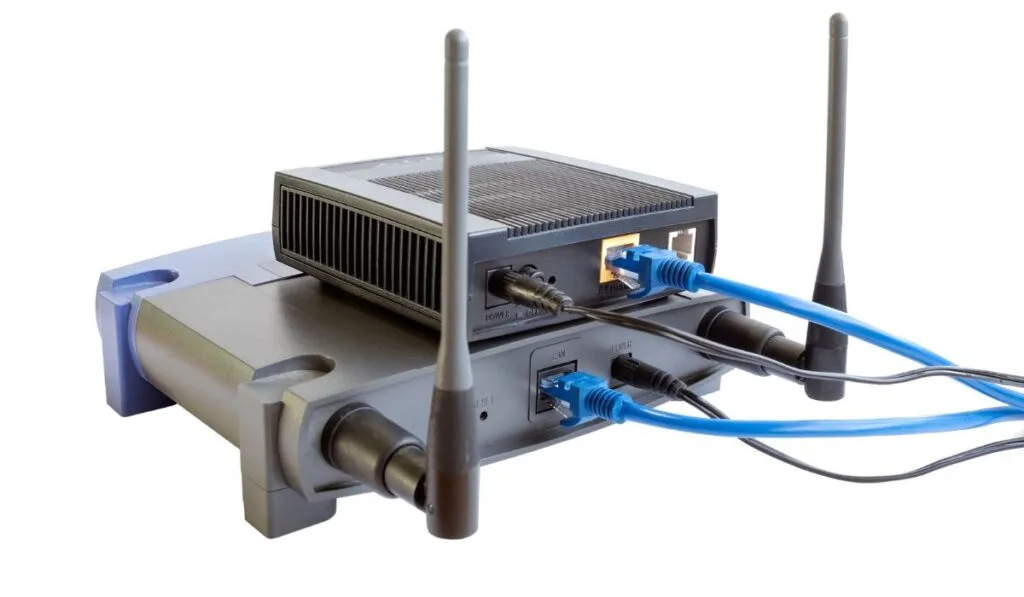You don’t necessarily have to choose between having a series of access points or a router. The two devices can actually work together to convert a wired network to a wireless one and create a seamless experience. Routers provide internet on their own, but an access point can help an existing network in several ways.
A router is a single unit that allows for the management of a home network. An access point allows for extended internet coverage through a modular series of devices that’s typically used in larger homes or businesses. A router can act as an access point but an access point cannot act as a router.
Figuring out whether a router or access point is necessary can be a bit confusing because they overlap in functionality, operation, and connectivity. However, routers and an access points are distinct in the way that they fill needs. For example, large-scale businesses operate on more complex networks than a single-family home.
What is a Router?

A router (on Amazon) is a network device that establishes internet connectivity within a home or office by means of a wired or wireless connection. This allows information to flow in and out of a local area network (LAN) through a wired Ethernet connection or wirelessly through Wi-Fi.
Most commonly, devices like smartphones, laptops, and TVs are connected through Wi-Fi. This all begins at the router. However, most routers combine the use of Ethernet ports and wireless options to provide different options to connect a device and the best service to the customer.
In order for a router to connect multiple devices to the internet, it must be connected to an internet service provider’s customer premises equipment (CPE) through the use of an Ethernet cable. This gives the router a centralized location that allows for additional network management options.
What is an Access Point?
An access point (on Amazon) is a wireless networking device that allows for a distribution of internet connectivity around a specific area. It can work in tandem with a router or on its own. The goal of an access point is to convert a wired LAN network into a wireless one through the use of an Ethernet cable (on Amazon).
The further you move away from a router, the worse its signal gets. Using access points allows the signal to be picked up and transmitted with better strength around your home or office. People with larger homes or office spaces may benefit from a mesh wifi router.
A network is capable of having multiple access points distributed through a single space. However, to use the access points, one must first be connected through the use of an Ethernet cable to the modem. Doing this allows all the networking devices to work together to create a seamless experience.
Access points can also increase the amount of devices that can connect to your network. The more devices you have connected to a signal network, the further that signal is stretched to accommodate each device using the internet. Adding an access point not only expands the networking coverage but also allows for more availability in its strength and number of units that can connect to it.
How Are Routers and Access Points Different?

Routers and access points essentially do the same thing, which often leads to the confusion about their differences. That said, there are a few things that set them apart and make them similar, but not the same.
Function
Routers (on Amazon) typically have several different functions that include: having an access point already installed, working as an Ethernet router, having a firewall built in, and also providing an Ethernet switch.
A router can be either wired or wireless and serve multiple devices at once. In contrast, an access point is always wireless. The point of an access point is to make a wired network wireless in order to connect to devices like smartphones, laptops, and TVs.
Wireless routers can act as an access point, but an access point can never act as a router. A router acts as a hub that sets up the local area network (LAN) and manages all the devices and connections of a single network.
An access point (on Amazon) can be considered a sub-device that connects to this existing network and allows more devices to connect wirelessly, but it can’t manage anything.
Connectivity
Typically, a router can connect wirelessly to devices directly and doesn’t need anything else to work. This can sometimes result in the signal being stretched too thin if the area of coverage is too large for the router’s capability, leading to dead spots and poor connection speeds.
Adding an access point to your existing network to work alongside your router can alleviate some of these issues by extending coverage and providing for additional devices that can be wirelessly connected.
You can also add multiple access points to a single network. However, only one router can be applied to a network at any given time. Using access points in conjunction with a router allows for a more modular setup and adaptable functionality as needs change.
Who Are Wireless Access Points Designed For?
Wireless access points can be beneficial to anyone in a large home or office space. Anyone who wants coverage for 3,000 square feet or more will need at least one access point.
Obstructions like walls, the space between different floors, and even other electronic devices will hurt an internet signal and therefore cause poor speeds and dead spots. Having access points will help with these issues and provide the optimal experience for work or play.
Who Are Routers Designed For?
Routers are designed for smaller areas of coverage, like small to medium sized homes or offices. Typically, a router’s internet coverage will be enough for anyone with a space of less than 3,000 square feet. Even then, it depends on the layout of the building and how many devices you need to connect.
